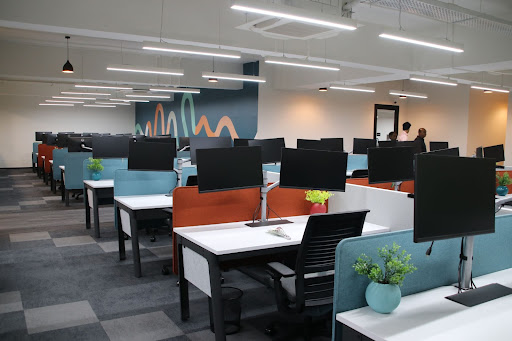With collaborative culture and adaptation to modern requirements, coworking spaces have become the talk of the town. Investing in a business that gives flexibility to the customers, ease in management, and customized membership deals have proven to be one of the best business models of recent times.
Especially in the 21st century, when the world is more connected, innovation makes human life more flexible and comfortable. Coworking spaces are here to solve the existential problem of a million start-ups, small-scale businesses, and freelancers.
Since its inception in 2005, the concept of the coexistence of different professionals and the business model of coworking spaces has shown a lot of potential in terms of growth.
Rather than committing to a rigid, commercial space, investors are more interested in managed offices with customizable options and minimal capital investment.
Coworking and office on rent are profitable options for the leases as they don't have to worry about the services like security, hospitality, and management. But can the same thing be said about coworking space owners? Is coworking a great business model? Let's find out.
How Does a Coworking Business Model Make Profits?

According to the 2nd Global Coworking survey responses, only 40% of coworking businesses are profitable on average. 72% of the coworking businesses gain profits after two years of operations. What does that tell us about the model?
The statistics show that more than 40,000 coworking spaces will be up and running worldwide by 2024. If the demand is so high, why doesn't the business model project enough profits?
Well, the business model earns profits in a variety of ways. It's time to see the business model throughout and see if it is a financially viable option and a detailed breakdown of the sources of revenue.
-
Accessible Locations
The first and foremost pointer to having a profitable coworking business is to set up the spaces in easily accessible locations. It attracts the majority of companies automatically. It gives the customers agility to come to the office. Accessibility in terms of finding a ride to the office and public transport also makes the location a significant factor in getting business in the coworking and making it profitable.
-
Memberships and Subscriptions
The largest share of profit in coworking is through the membership plans they offer their customers. When it comes to coworking, it doesn't have customers and owners, but they are members of the business together. So the longer the membership lasts, the more profitable it is for the coworking spaces and the people working there.
Also, some professionals prefer working from home, so they occasionally need to work from the office for a client meeting or important presentation. They work on a subscription model. Like subscribing to Spotify to listen to music, coworking spaces are subscribed to depending on working days. People can subscribe for the whole month or just several days.
-
Partnerships for Renting Amenities
Coworking works on a model of providing comfortable and casual spaces for working professionals to take care of the rest. The rest include security, amenities like a cafeteria, gyms, recreational rooms, hospitality, and management of the spaces. Collaborating with locals from specific regions helps coworking spaces to save money on spending and earning from the membership packages.
-
Events and Organizing Workshops
Along with renting office spaces, the conference and meeting rooms are separately rented. It is either included in the membership package that the business chooses or rented as an additional service to the existing business members or potential members.
The spaces are even used for marketing and promoting different businesses via organizing events. Sometimes, space is rented to organize workshops by other professionals.
Expenses Incurred by the Coworking Spaces
Although there are multiple ways of making profits for a coworking space as a business model, they have to incur hundreds of expenses, from operational costs to paying the services, infrastructure, and customization costs.
Coworking as a business model is successful and profitable when the income is far higher than the cost they have to bear to keep the space functional.
-
Infrastructure Customisation Charges

It has been said a hundred times that coworking allows you to choose your desired infrastructure and designs. Reputed coworking spaces fulfill their promise, but they do have to bear all the customization charges. Though they are one-time charges, infrastructure includes interior designs, furniture procurement, painting, carpentry, etc.
-
Regular Operational Costs
Generally, the operational costs are slightly higher in coworking spaces than in typical commercial leases. They must hire an IT team or coworking software to manage all the regular subscriptions and memberships for the people booking the spaces. Also, data security and security in the building have to take excellent care of. No comprise in the safety of the people, and even their data can be taken lightly.
-
Day-to-day Utilities
Day-to-day utilities like electricity, cooling, ventilation, refrigeration, water coolers, etc., must be taken care of by the coworking businesses. These are non-negotiable expenses that have to be paid even if the occupancy is 1% or 100%
Ways to Make More Money
The coworking model was successful and rising every day during the pandemic, which took more than two years. People have become accustomed to working from home. So to make coworking profitable in the current times, a new marketing strategy is needed. To attract more crowds to work from coworking spaces and simultaneously ensure that the rooms give profits after incurring the operational expense.
There is more than one way of making the coworking business model more profitable.
- Virtual Renting is a way forward to make more profit. Providing a virtual office as a service is just a professional work address used by potential clients for mail, advertising, and deliveries. It makes them look professional while working from home and benefit the space from virtually renting.
- Promotional activities at discounted rates can help spaces organize more regular events and workshops. A collaborative culture in coworking spaces can attract professionals from their respective fields. It gives a platform to passively advertise the coworking space once they get the look and feel of the room.
- Targeting the high spending customers is a great way forward for the coworking business model. Although spaces are highly beneficial for start-ups and freelancers, attracting high-spending customers to shift their business to the areas compared to their usual commercial spaces or set up satellite offices will increase revenues.
Conclusion
To have a successful business model, it is understood to need at least a year before making a profit. The same applies to coworking as well. Coworking is a community center where people, regardless of their backgrounds and professions, can unite and work as a community. While it gives them a chance to collaborate, occupancy going up to 90-100% for space owners makes it a profitable model.
To increase profits, a good marketing team can promote the spaces on digital and local platforms to attract potential members. A single successful room can build up profits to open multiple areas at different locations.
Author Bio
Parth Shah, a Co-Founder, COO of DevX accelerator has 10 years of experience in operations and training. Parth is a go-to person for his team and even a multitude of growing start-ups. His knack lies at spotting and supporting start-ups, helping them streamline their processes and even taking their ventures to the next level. After successfully establishing two start-ups and exploring the start-up landscape up-close Parth has learnt the nitty-gritty of the industry, which he now shares with fellow entrepreneurs.


No comments yet